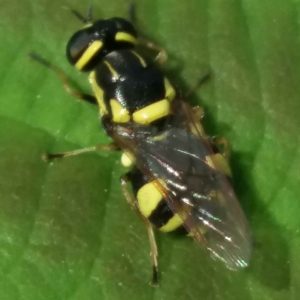…a guest blog written by Martin Harvey of the Soldierflies and Allies Recording Scheme as part of our COP28 impacts of climate change on invertebrates series.
An entomologist is always on the lookout for interesting insects, even in unlikely places! In early July 2023, Chris Barlow was inspecting a wooden fence around a supermarket car park in North Tyneside. Perhaps not the first place that springs to mind as good habitat for insects, but Chris knew that the fence was a favourite basking post for a variety of species. And on this occasion there was a newcomer among the usual fence-post crowd: the Four-barred Major Soldierfly (Oxycera rara). This distinctive black and yellow fly breeds in wetlands, and was probably using the fence to warm itself up before heading over to the ponds and ditches of the adjacent nature reserve.
It’s always interesting to find a species that you haven’t seen before, and what was even more exciting in this case was that it was the first ever record of this species in South Northumberland, representing a jump of 30–40 km from the previous most northerly record. It was swiftly followed by another record that Chris made the same day, at a different location a kilometre or so north of the first sighting.

But the Four-barred Major didn’t stop there: a couple of weeks later David Notton recorded this species at Lauriston Agroecology Farm, on the Firth of Forth coast near Edinburgh. This was the first ever record for Scotland, and pushed the known range further north by some 100 km. The habitat here was a more typical wetland with ponds, in an area of the farm set aside for nature. More of the soldierflies were seen in subsequent visits so it seems likely to be breeding, and benefiting from the wildlife-friendly management at this farm.
As recording scheme organiser it’s always exciting to see records coming in from new places and showing how the flies are moving around and surprising us. But alongside the pleasure of seeing a species do well is the concern about what this actually means for biodiversity in general. It is very likely that some aspect of climate change is driving these changes, and although an expansion of range may be a good thing for the Four-barred Major, other species will be facing challenges as they try to find the conditions they need in a rapidly changing environment. Soldierflies, along with many other types of fly, rely on finding wet habitats of one sort or another for their larvae to develop in.
Climate change may increase the frequency of droughts at certain times and places, or conversely may result in more severe flooding incidents, neither of which will benefit species that depend on finding sheltered, shallow waters in which to breed.

This means that seeing species on the move generates mixed feelings.
It’s encouraging that at least some species appear to be resilient and are able to disperse to find new opportunities, but at the same time it’s concerning that climate changes are leading to more extreme conditions. And species that have more specialised habitat requirements are likely to struggle to find what they need as their world changes around them.
What can we do about this?
Support for conservation organisations such as Buglife and others is as important now as it has ever been. You may also want to consider supporting campaigns aimed at preventing climate crisis, such as limiting the use of fossil fuels. And as entomologists and naturalists we can all be like Chris and David: look out for the wildlife around us, and send in records of what we see so that changes can be tracked and, where possible, conservation action can be taken.
Want to know more? For more about soldierflies, including downloadable identification guides, visit the Soldierflies and Allies Recording Scheme website.
If you have records and photos of soldierflies and allies (including bee-flies, robberflies and related groups) please add them to iRecord or see the records information here.
You can also follow the Soldierflies and Allies Recording Scheme on both Twitter (X) and Facebook